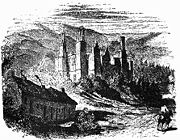
Castle Caulfield
Encyclopedia

Castlecaulfield
Castlecaulfield is a small village in County Tyrone, Northern Ireland. It lies about three kilometres west of Dungannon and is part of the Dungannon and South Tyrone Borough Council area. The village is mostly within the townland of Drumreany, although part of it extends into Lismonaghan....
, County Tyrone
County Tyrone
Historically Tyrone stretched as far north as Lough Foyle, and comprised part of modern day County Londonderry east of the River Foyle. The majority of County Londonderry was carved out of Tyrone between 1610-1620 when that land went to the Guilds of London to set up profit making schemes based on...
, Northern Ireland
Northern Ireland
Northern Ireland is one of the four countries of the United Kingdom. Situated in the north-east of the island of Ireland, it shares a border with the Republic of Ireland to the south and west...
. It is a large house built by Sir Toby Caulfeild between 1611 and 1619 on the site of an earlier O'Donnelly castle. A joist
Joist
A joist, in architecture and engineering, is one of the horizontal supporting members that run from wall to wall, wall to beam, or beam to beam to support a ceiling, roof, or floor. It may be made of wood, steel, or concrete. Typically, a beam is bigger than, and is thus distinguished from, a joist...
from one of the walls was dated using dendrochronology
Dendrochronology
Dendrochronology or tree-ring dating is the scientific method of dating based on the analysis of patterns of tree-rings. Dendrochronology can date the time at which tree rings were formed, in many types of wood, to the exact calendar year...
to about 1282 and may belong to this earlier fort. There are substantial remains. The oldest part of the existing building is the gatehouse, which has Tudor-style doorways, murder-hole
Murder-hole
A murder hole or meurtrière is a hole in the ceiling of a gateway or passageway in a fortification through which the defenders could fire, throw or pour harmful substances, such as rocks, arrows, scalding water, hot sand, quicklime, tar, or boiling oil, down on attackers. They also allowed water to...
s and gun-loops. The Caulfeild arms appear over the entrance. The building is three storeys high with attics, many large mullioned windows and tall chimneystacks. The castle was burned in the Irish Rebellion of 1641
Irish Rebellion of 1641
The Irish Rebellion of 1641 began as an attempted coup d'état by Irish Catholic gentry, who tried to seize control of the English administration in Ireland to force concessions for the Catholics living under English rule...
but was repaired and reoccupied by the Caulfeilds until the 1660s. Oliver Plunkett
Oliver Plunkett
Saint Oliver Plunkett was the Roman Catholic Archbishop of Armagh and Primate of All Ireland....
is known to have held a service at the castle in 1670, but the castle was in ruins when John Wesley
John Wesley
John Wesley was a Church of England cleric and Christian theologian. Wesley is largely credited, along with his brother Charles Wesley, as founding the Methodist movement which began when he took to open-air preaching in a similar manner to George Whitefield...
preached there in 1767.
Castle Caulfield, today a ruin, is a State Care Historic Monument in the townland
Townland
A townland or bally is a small geographical division of land used in Ireland. The townland system is of Gaelic origin—most townlands are believed to pre-date the Norman invasion and most have names derived from the Irish language...
of Lisnamonaghan, in Dungannon and South Tyrone Borough Council
Dungannon and South Tyrone Borough Council
Dungannon and South Tyrone Borough Council is a local council in Northern Ireland. Its main town is Dungannon, where the council is headquartered. The council area covers the southern part of County Tyrone and has a population of nearly 48,000...
area, at grid ref: H7550 6260.

